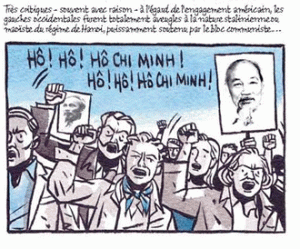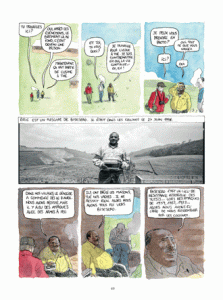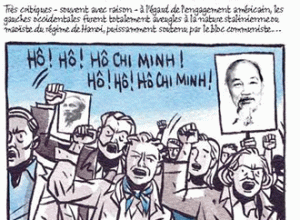
What comics and photography have in common is that they both emerged in the early nineteenth century while giving shape to their authors’ imaginaries. Isabelle Delorme, who is preparing a dissertation at Sciences-Po on historical graphic memoirs, calls to mind the growing role of photography in graphic albums which have themselves been on the increase since the turn of the twenty-first century. Hovering between subjective narrative and objective facts, such albums reactivate personal memories in accordance with the quite special codes memory establishes. Photography plays a major role therein, as it always has done in “authenticating” reality.
Laurence Bertrand Dorléac
Isabelle DelormePractices and Incursions of Photography in Historical Graphic Memoirs
Comics and photography are arts involving images and imaginaries that both came into being during the first half of the nineteenth century. This proximity leads one to inquire about the place photography occupies in graphic albums, particularly in historical graphic memoirs, a new genre of comic books that has developed since the early 2000s and that is based on an author’s personal memories (Marjane Satrapi’s Persepolis1) or on the memory of someone extremely close to the author (Art Spiegelman’s Maus)2. These tales that are subjective in character but that are ones in which the veracity of the facts recounted is of key importance depend on a desire to share a memory, make reference to a specific historical episode (often one from the twentieth century), and are situated in identifiable geographical spaces. They concern intimate, almost exclusively personal and/or family memories, though upon exception they concern memories shared by a friend, and they have in common certain special textual and graphical characteristics.

Fig. 1. Marcelino Truong, Une si jolie petite guerre, Saigon 1961-63, p.261, © Denoël Graphic.
Photography’s Frequent and Protean Presence in Historical Graphic Memoirs
One finds in these albums reproductions of old traditionally-produced photographs, almost all of them in black and white even when the comic books are done in color. Quite often, the photographs inserted into these narratives are individual portraits, taken full-length or head-and-shoulder, though in some cases they involve portraits representing a family group with just a few people, often close kin, such as brothers and sisters, parents, and so on. In Une si jolie petite guerre, Saigon 1961-63,3 Marcelino Truong chose to insert two black-and-white photographic portraits of Ho Chi Minh, on supporters’ placards, within a panel drawn in color representing Western left-wing protestors. This process allows the author to offer an exact representation of the Vietnamese leader.
Also to be found in these narratives are some recent digital photographs. In La fantaisie des Dieux, Rwanda 1994,4 Hippolyte and Patrick de Saint Exupéry introduced into a color album some black-and-white photographs taken in 2013 as a way of giving material form to the past and of returning to the events involved in the 1994 Rwandan genocide, to which Patrick de Saint-Exupéry was an eyewitness.
Furthermore, photographs are frequently redrawn in such albums. Here we have old traditionally-produced photographs that have been reproduced in the most faithful way possible, that are often represented with serrated edges held by someone’s thumbs, and that are commented on by the person who holds them in his or her hand. The drawing may have been executed expressly on the basis of a photograph: when the reader looks at the plate, she can have no doubt that she is in the presence of a digital shot that has been altered with the aid of software designed for photo editing, photo processing, and computer-assisted drawing. This is the case with the first pages in Emmanuel Guibert’s L’enfance d’Alan,5 where the author sets the reader off onto the highways of California, headed for Pasadena and Hollywood. The reference to photography may also be implicit in a drawing, as when the drawing has clearly been constructed on the basis of a photograph, though no element in the drawing formally indicates that. It is the precision of the panels and the comparison with a photographic picture of the events being drawn that allows the reader to be sure that one has had recourse to that medium.
Finally, we may note, the way the photographs are positioned varies from album to album. The shots may be found within the narrative itself. In this case, either the photograph is isolated within a drawn plate or it takes up a plate of its own. The entire page is then covered by a single photograph or else by an accumulation of shots shown in multiple frames. When photographs are redrawn, they are inserted within the memoir. Shots that are external to the narrative are often situated at the beginning of the album, as a photographic incipit. In that case, we have an individual portrait showing the hero of the book, that is to say, the person whose history is being narrated, before one comes upon his drawn representation. In other cases, an addendum made up of notes and photographs (up to a dozen shots in Jérémie Drès’s Nous n’irons pas voir Auschwitz)6 is appended at the end of the album to fill out certain aspects of the memoir.
The insertion of photographs is a near systematic practice within these historical graphic memoirs, though it is done in various forms, which is a phenomenon we do not observe as often in other types of comic-book works, particularly fictional ones. The clear use of photography in graphic albums always relates to a specific artistic approach. Guibert, for example, is the scenarist and illustrator for The Photographer,7 an exceptional album that hovers between the comic-book form and a photojournalistic account of a 1986 mission of Doctors Without Borders during the first Afghanistan War. That album mixes together, in a unique way, drawings and hundreds of snapshots, presented separately or on contact sheets, which occupy one or several panels per page, and sometimes the entire page. In another vein, Dave McKean does albums in which, within one plate, drawings, color photographs, collages of documents, and even newspaper pages can be mixed together with the aid of computer-processing programs and, in particular, of Photoshop software.
This therefore leads us to think that the use of the medium of photography in historical graphic memoirs answers to several needs.

Fig. 2. Hippolyte Patrick de Saint-Exupéry, La fantaisie des Dieux, Rwanda 1994, p.49, © Les Arènes.
Photography Fulfills Several Functions, Including Attestation, Memorization, and Aid in the Creation of Graphic Albums
A drawing cannot attest that objects have been arranged as it presents them to us or that the artist has ever physically been present before those objects. On the contrary, images resulting from the practice of photography attest to both these facts, as Roland Barthes recalls in Camera Lucida: “The noema of photography is simple, trivial; it has no depth whatever: ‘This has been.’”8
Photography partakes in the process of the memorization of individual and collective history. When this technique is employed within a graphic album, it helps to reinforce people’s memories and heighten the narrative’s connection with private life and the past. Indeed, the author seeks above all to retain memory of the life of someone close to him, but showing that person’s photographic representation to the reader is a way of sharing with another the reality of that person’s existence and augmenting, one might say, his memory-surface. Furthermore, it may be said that, as these individual stories recount a part of our contemporary history, the insertion of photographic shots that testify to facts relating to twentieth-century events augments our capacity to remember them.
Photographs also play a role of assisting in the creation of these albums, a practice noted as early as the second half of the nineteenth century, since a good number of engraved drawings were executed on the basis of a photograph. This trend became more pronounced in the twentieth century and, along the lines of Hergé and, more recently, of Jacques Tardi, many authors possess quite large photographic archives which they make use of for their creative work. Since then, the use of digital technology has stepped up the recourse to photography, which is most often hidden, as Thierry Groensteen has noted. Indeed, photographic documents are converted by computer into drawings—to the point that one no longer even suspects that the medium has been employed. A large number of present-day authors, such as Marcelino Truong, build up a bank of photographic data discovered on the Internet which they mine for the scenes they wish to draw.
Photography is a medium that is highly present in historical graphic memoirs, and much more so than painting. This major presence of photography may be explained by the medium’s pronounced capacity to attest to and recall facts, particularly in traumatic historical events and especially in the case of the Shoah. It is not to be explained by an artistic approach centered around photography, even when authors have made a genuine artistic choice to integrate photographs within their albums. Furthermore, it may be pointed out that the boundaries between drawing and photography have been blurred since the appearance of digital technology, and an artist can now produce images that are quite close to reality. There is a relative homogeneity to the way authors process images: like drawings, photographs, whether identically reproduced or redrawn, are accompanied by texts, which can corroborate the shots. The multiplicity of images—that is to say, the addition of photographs to drawings in historical graphic memoirs—allows one to give greater density to the recollection and memory of narrated facts.
Notes
1 Marjane Satrapi, Persepolis (New York: Pantheon Books, 2003) and Persepolis 2: the Story of a Return (New York : Pantheon Books, 2004).
2 Art Spiegelman, Maus I: A Survivor’s Tale: My Father Bleeds History (New York: Pantheon Books, 1986) and Maus II : And Here My Troubles Began (New York: Pantheon Books, 1991).
3 Marcelino Truong, Une si jolie petite guerre, Saïgon 1961-63 (Paris: Denoël Graphic, 2012).
4 Hippolyte and Patrick de Saint-Exupéry, La fantaisie des Dieux, Rwanda 1994 (Paris: Les arènes, 2014).
5 Emmanuel Guibert, L’enfance d’Alan (Paris: l’Association, 2012).
6 Jérémie Drès, Nous n’irons pas voir Auschwitz (Paris: Cambourakis, 2011).
7 Emmanuel Guibert, Didier Lefèvre, and Frédéric Lemercier, The Photographer (2003-2006), trans. Alexis Siegel (New York: First Second, 2009).
8 Roland Barthes, Camera Lucida: Reflections on Photography (1980), trans. Richard Howard (New York: Hill and Wang, 1981), p. 193.
Bibliography
BARTHES Roland. Camera Lucida: Reflections on Photography (1980). New York: Hill and Wang, 1981.
DELANNOY Pierre-Alban. Maus d’Art Spiegelman, bande dessinée et Shoah. Paris: L’Harmattan, 2002.
GROENSTEEN Thierry. Entry on Photographie in Dictionnaire esthétique et thématique de la bande dessinée. neuvièmeart2.0 (online review of the Cité Internationale de la Bande Dessinée et de l’Image).
HIRSCH Marianne. Family Frames: Photography Narrative and Postmemory. Cambridge, MA: Harvard University Press, 1997. New ed. 2012.

